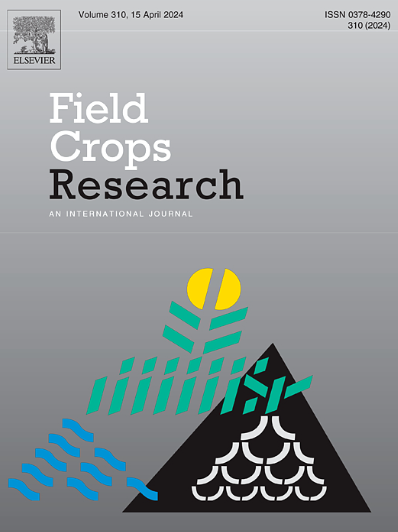Suitability assessment of film mulching on maize production in Northwest China: Integrating meta-analysis with machine learning
IF 5.6
1区 农林科学
Q1 AGRONOMY
引用次数: 0
Abstract
Context
Film mulching (FM) is commonly used in Northwest China to address water scarcity in agriculture by promoting soil warming and moisture retention. However, FM is not suitable for all regions, and excessive reliance on this method can lead to overuse, which may harm the farmland ecosystem. Understanding where and how FM is most effective is crucial for ensuring its sustainable use.
Objective
This study assessed the suitability of FM on maize considering yield and water use efficiency (WUE) in Northwest China by integrating meta-analysis with machine learning techniques. In addition, the analysis aimed to assess the regional and environmental factors influencing FM performance.
Methods
A meta-analysis was conducted, synthesizing data from 141 studies, to evaluate the influence of FM on maize yield and WUE. Machine learning models, including Random Forest regression, support vector regression, and gradient boosting regression tree, were applied to predict the regional suitability of FM based on climatic, soil, and management practices. Key factors influencing the effect of FM included climatic factors (mean annual precipitation and mean annual temperature), soil characteristics (bulk density, soil organic matter, and total nitrogen), and fertilization strategies (nitrogen and phosphorus). Pearson correlation analysis was conducted to explore the relationship between the 7 factors and the effectiveness of FM, while Random Forest was utilized to prioritize the importance of each factor.
Results
The meta-analysis revealed that FM increased maize yield by 40.55 % and WUE by 40.79 %. Plastic mulch demonstrated superior effectiveness, improving yield by 43.68 % and WUE by 43.85 %. FM performed best under conditions of scarce resources. Among the 7 factors, mean annual precipitation, mean annual temperature, and total nitrogen were of higher importance in the prediction. Random Forest regression excelled in predicting yield and WUE changes. The spatial analysis revealed notable regional variability of FM, with the best results observed in Xinjiang and Gansu.
Conclusions
This study highlighted the effectiveness of FM in improving maize yield and WUE in Northwest China, with regional variability in its performance. The results indicated that FM was most beneficial in regions with limited water and heat, particularly in Xinjiang and Gansu. Moreover, the study also demonstrated the utility of machine learning models, particularly Random Forest regression, in predicting FM suitability across regions.
Significance
This study offered valuable insights into the regional suitability of FM for maize production in Northwest China, providing guidance for agricultural policy and management decisions to enhance the sustainability of FM. In addition, by integrating meta-analysis with machine learning, it presented an effective method to predict FM's impact on crop yield and water use efficiency.
西北地区玉米覆膜适宜性评价:meta分析与机器学习相结合
地膜覆盖(FM)是中国西北地区普遍采用的一种通过促进土壤增温和保墒来解决农业缺水问题的方法。然而,调频并非适用于所有地区,过度依赖这种方法可能导致过度使用,从而损害农田生态系统。了解FM在哪里以及如何最有效,对于确保其可持续利用至关重要。目的采用meta分析和机器学习相结合的方法,综合考虑玉米产量和水分利用效率(WUE),评价玉米调养在西北地区的适宜性。此外,分析旨在评估影响调频绩效的区域和环境因素。方法采用meta分析方法,综合141项研究资料,评价调剂对玉米产量和水分利用效率的影响。采用随机森林回归、支持向量回归和梯度增强回归树等机器学习模型,基于气候、土壤和管理实践预测FM的区域适宜性。影响调频效果的关键因素包括气候因素(年平均降水量和年平均气温)、土壤特征(容重、土壤有机质和全氮)和施肥策略(氮磷)。通过Pearson相关分析探讨7个因素与FM有效性之间的关系,并利用Random Forest对各因素的重要性进行排序。结果经荟萃分析,玉米调剂产量提高40.55 %,水分利用效率提高40.79 %。覆膜效果较好,产量提高43.68 %,水分利用效率提高43.85 %。在资源稀缺的条件下,调频表现最好。在7个因子中,年平均降水量、年平均气温和总氮对预测的重要性较高。随机森林回归对产量和水分利用效率变化的预测效果较好。空间分析显示,土壤调频的区域差异显著,其中新疆和甘肃的调频效果最好。结论FM在提高西北地区玉米产量和水分利用效率方面具有显著效果,但其效果存在区域差异。结果表明,在水热条件有限的地区,特别是新疆和甘肃,调频最有利。此外,该研究还证明了机器学习模型,特别是随机森林回归,在预测跨地区FM适用性方面的实用性。意义本研究为研究中国西北地区玉米调养的区域适宜性提供了有价值的见解,为农业政策和管理决策提供了指导,以提高调养的可持续性。此外,通过将元分析与机器学习相结合,提出了一种预测FM对作物产量和水分利用效率影响的有效方法。
本文章由计算机程序翻译,如有差异,请以英文原文为准。
求助全文
约1分钟内获得全文
求助全文
来源期刊

Field Crops Research
农林科学-农艺学
CiteScore
9.60
自引率
12.10%
发文量
307
审稿时长
46 days
期刊介绍:
Field Crops Research is an international journal publishing scientific articles on:
√ experimental and modelling research at field, farm and landscape levels
on temperate and tropical crops and cropping systems,
with a focus on crop ecology and physiology, agronomy, and plant genetics and breeding.
 求助内容:
求助内容: 应助结果提醒方式:
应助结果提醒方式:


